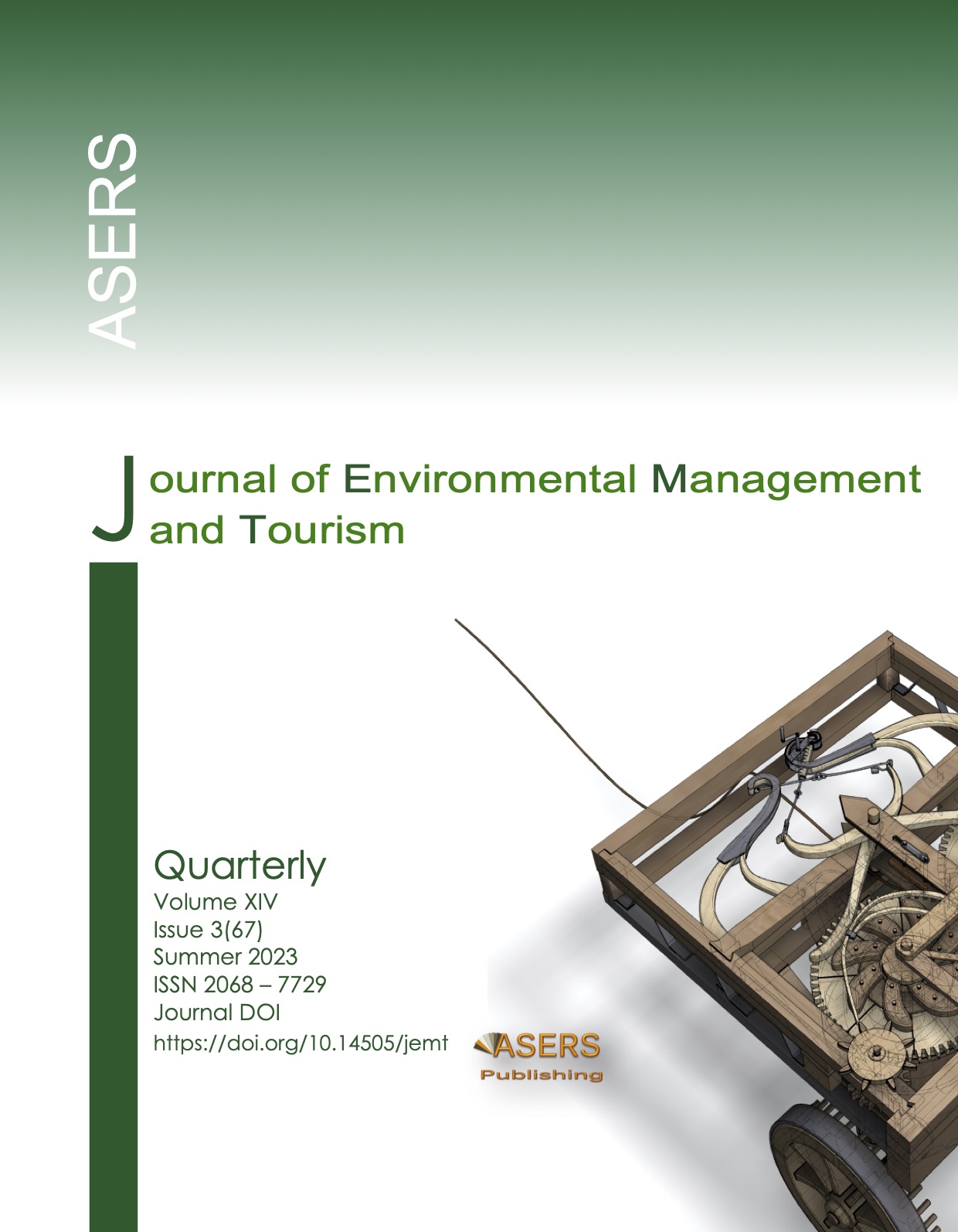Exploring Environmental Factors for the Sports Clusters Development
Abstract
The development of a sports cluster is an important social task, the solution of which contributes not only to the balance of the local economy, but also to the involvement of the most progressive segments of the population in entrepreneurial activities, tending to a proper lifestyle and active leisure. The growth of entrepreneurial activity in this segment of the economy is determined by many factors, including the state policy for the development of sports and tourism. As a global industry, sport is a potentially significant contributor to climate change, both through carbon emissions and through its impact on sustainable development practices. The purpose of the study is to explore environmental factors influencing the development of the sports cluster in the Kazakhstan and further prospects for its development using forecasting and modelling methods. The environmental policy of the sports movement must be carried out within the broader framework of sustainable development. The environmental work of the sports movement is currently focused on the protection and management of resources and the natural environment in order to improve social and economic conditions. All this should be aimed at education on environmental issues and specific measures for its protection.
References
[2] Ahmedova, S. 2019. Factors for increasing the Competitiveness of Small and Medium Sized Enterprises (SMEs). Bulgari/Procedia - Social and Behavioral Sciences, 195: 1104-1112. DOI:https://doi.org/10.1016/j.sbspro.2015.06.155
[3] Bernard, P., et al. 2020. Climate change, physical activity and sport: a systematic review. Sports Medicine, 51: 1041-1059. DOI: https://doi.org/10.1007/s40279-021-01439-4
[4] Brocherie, F., Girard, O., and Millet, G. P. 2019. Emerging environmental and weather problems in outdoor sports. Climate, 3(3): 492-521. DOI: https://doi.org/10.3390/cli3030492
[5] Dagnino, G., Levanti, G., Minà, A., and Picone, P. 2018. Interorganizational network and innovation: A bibliometric study and proposed research agenda. Journal of Business & Industrial Marketing, 30(3/4): 354-377. DOI: https://doi.org/10.1108/JBIM-02-2013-0032
[6] DeChano-Cook, L. M., and Shelley, F. M. 2017. Climate Change and the Future of International Events: An example of the Olympic and Paralympic Games. Routledge: Handbook of Sport and the Environment, 66-78pp. ISBN: 978-1315619514
[7] Dingle, G., Dickson, G., and Stewart, B. 2022. Major sports stadiums, water resources and climate change: Impacts and adaptation. European Quarterly Journal of Sports Management, 2(9): 20-29. DOI:https://doi.org/10.1080/16184742.2022.20
[8] Dingle, G. W., and Stewart, B. 2018. Playing the climate game: The impact of climate change, resilience and adaptation in the climate-dependent sports sector. Sports and Leisure Management, 23: 293-314. DOI:https://doi.org/10.1080/23750472.2018.1527715
[9] Etzkowitz, H., and Leydesdorff, L. 2018. Universities in the Global Economy: A Triple Helix of University-Industry-Government Relations. London: Cassell Academic, 330p. ISBN: 978-1855674219
[10] Fundeanu, D., and Badele, C. 2014. The impact of regional innovative clusters on competitiveness. Procedia - Social and Behavioral Sciences, 124: 405 – 414.DOI:10.1016/j.sbspro.2014.02.502
[11] Gerke, A. 2018. Towards a network model of innovation in sport – the case of product innovation in nautical sport clusters. Innovation: Management, Policy & Practice, 7(1): 38-44. DOI:https://doi.org/10.1080/14479338.2016.1237306
[12] Gerke, A., Woratschek, H., and Dickson, G. 2020. The sport cluster concept as middle-range theory for the sport value framework. Sport Management Review, 23(2): 200-214. DOI:https://doi.org/10.1016/j.smr.2018.12.004
[13] Heaney, A. K., et al. 2019. Climate change and physical activity: The estimated impact of ambient temperature on the use of bicycle sharing in New York. Surround. Health Perspective, 127:037002. DOI:https://doi.org/110.1289/EHP4039
[14] Hodgson, J. R., et al. 2020. The influence of meteorology and air quality on the sports results of Parkrun. Parkrun District, 22p. Available at: https://awrcparkrunresearch.wordpress.com/category/archived-research-projects/page/2/
[15] Hongye, L., and Di, P. 2022. Ecological efficiency analysis of the ice and snow sports industry based on the cost-output system. Mathematical Problems in Engineering, 3(10): 761-770. DOI:https://doi.org/10.1155/2022/5022761
[16] McCullough, B. P., Orr, M., and Kellison, T. 2020. Sports ecology: Conceptualization of the emerging subdiscipline in sports management. Journal of Sports Management, 1: 1-12. DOI:https://doi.org/10.1123/jsm.2019-0294
[17] Orr, M., Inoue, Y., Seymour, R., and Dingle, G. 2022. The impact of climate change on organized sport: An overview of the scope. Interdisciplinary Reviews of Wiley: Climate Change, 13(3). DOI:https://doi.org/10.1002/wcc.760
[18] Orr, M., and Schneider, I. 2018. Substitution of interests among active sports tourists: The case of a cross-country skiing competition. Journal of Sport & Tourism, 22(4): 315–332. DOI:10.1080/14775085.2018.1545600
[19] Porter, М. 2018. Competition. Мoscow: Wiiliams, 608 p.
[20] Schneider, S., et al. 2022. Physical activity, climate change and health – a conceptual framework for organizational public health action planning. International Journal of Environmental Research and Public Health, 19(8): 4664. DOI: https://doi.org/10.3390/ijerph19084664
[21] Scott, D., et al. 2022. Climate change and the future of the Winter Olympic Games: perspectives of athletes and coaches. Topical Issues of Tourism, 9(3): 34-41. DOI: https://doi.org/10.1080/13683500.2021.20234
[22] Stamatakis, E., Nnoaham, K., Foster, K., and Scarborough. 2019. The impact of global warming on discretionary physical activity: An important and underestimated consequence of climate change. Journal. Physical. Act. Health, 10: 765–768. DOI: https://doi.org/10.1123/jpah.10.6.765.
[23] Svensson, Per G., and Hambrick Marion, E. 2019. Exploring how external stakeholders shape social innovation in sport for development and peace. Sport Management Review, 22(4): 540-552. DOI:https://doi.org/10.1016/j.smr.2018.07.002
[24] Townsend, M., et al. 2023. Is it too hot to trot? Exploring potential links between climate change, physical activity and health. Journal of Science and Medicine in Sports, 6: 260-265. DOI:https://doi.org/10.1016/s1440-2440(03)80019-1
[25] Veliyeva, B., et al. 2018. The effect of ultraviolet light on mood, depressive disorders and well-being. Photodermatol. Photoimmunol. Photomed, 34: 288–297. DOI: https://doi.org/10.1111/phpp.12396
[26] Wang, Y., and Li, M. 2019. Regional characteristics of sports industry profitability: Evidence from China’s province level data. Physica A: Statistical Mechanics and its Applications, 525: 946-955. DOI:https://doi.org/10.1016/j.physa.2019.03.066
[27] Yelkikalan, N. 2018. Clustering approach as a regional development tool. Procedia - Social and Behavioral Sciences, 58: 503 – 513. DOI: 10.1016/j.sbspro.2012.09.1027
[28] *** Official resource of Data from the Bureau of National Statistics of the Agency for Strategic Planning and Reforms of the Republic of Kazakhstan for 2020-2022. Available at: http://www.stat.gov.kz
Copyright© 2025 The Author(s). Published by ASERS Publishing 2025. This is an open access article distributed under the terms of CC-BY 4.0 license.
